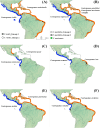Evolutionary history of the snooks: Phylogeny, biogeography and diversification of the genus Centropomus
- PMID: 41066314
- PMCID: PMC12510552
- DOI: 10.1371/journal.pone.0332412
Evolutionary history of the snooks: Phylogeny, biogeography and diversification of the genus Centropomus
Abstract
The snooks (Centropomus spp.) are a group of 13 morphologically similar fish species that are widely distributed off the Atlantic and Pacific coasts of the Americas. This study used a multilocus approach to assess the evolutionary relationships within the genus, and to estimate the divergence times of all the taxa. A total of 105 specimens were analyzed throughout the geographic distribution of the different species. The results of the analyses suggest that the genus Centropomus is composed of four species groups, which originated in the Miocene (~20 Ma) with the common ancestor of the genus probably inhabiting coastal environments in the Americas prior to its diversification. However, most of the cladogenetic events that determined the extant diversity of the genus occurred more recently, during the Pliocene-Pleistocene transition. The samples analyzed here permitted identify three distinct clades within the C. parallelus/C. mexicanus complex, with Centropomus mexicanus likely being restricted to the Gulf of Mexico. The results of the present study also corroborated the existence of two distinct lineages in Centropomus parallelus and identified two previously undescribed lineages in Centropomus viridis. The estimates of divergence times indicated that the formation of the Isthmus of Panama played an important factor in the evolution of the snooks, as weel as oscillations in sea level and ecological adaptations. The type of habitat is related to the evolutionary history of the genus, with the ancestral forms likely inhabiting riverine shoreline environments. Our findings highlight the importance of spatially comprehensive sampling for a better understanding of the evolutionary history of the centropomids, and reinforce the need for a more comprehensive taxonomic review of the genus Centropomus.
Copyright: © 2025 Malcher et al. This is an open access article distributed under the terms of the Creative Commons Attribution License, which permits unrestricted use, distribution, and reproduction in any medium, provided the original author and source are credited.
Conflict of interest statement
The authors declares that they have no conflict of interest related to the publication of this manuscript.
Figures





References
-
- Girard MG, Davis MP, Smith WL. The Phylogeny of Carangiform Fishes: Morphological and Genomic Investigations of a New Fish Clade. Copeia. 2020;108(2):265. doi: 10.1643/ci-19-320 - DOI
-
- Nelson JS, Grande TC, Wilson MV. Fishes of the World. 5 ed. Hoboken, New Jersey: John Wiley & Sons. 2016.
-
- Rivas LR. Systematic review of the perciform fishes of the genus Centropomus. Copeia. 1986;1986(3):579–611.
-
- Malcher G, Amorim AL, Ferreira P, Oliveira T, Melo L, Rêgo PS, et al. First evaluation of the population genetics and aspects of the evolutionary history of the Amazonian snook, Centropomus irae, and its association with the Amazon plume. Hydrobiologia. 2023;850(9):2115–25. doi: 10.1007/s10750-023-05223-5 - DOI
MeSH terms
LinkOut - more resources
Full Text Sources
Miscellaneous

